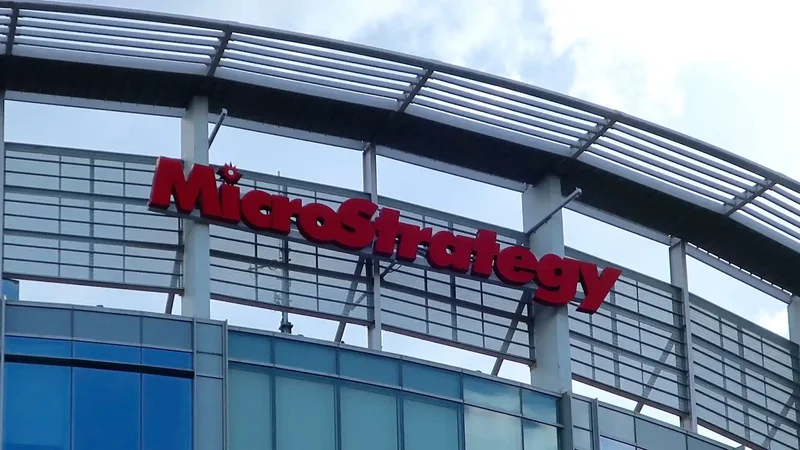The Unraveling of a Company: How MicroStrategy Became a Bitcoin Derivative
There's a number that explains everything you need to know about the company now called Strategy. It’s not the 640,031 bitcoins it holds, nor is it the $97 billion market cap. It’s this: in the second quarter of 2025, the company generated $114 million in revenue from its legacy software business and spent $6.7 billion acquiring more Bitcoin. That isn't a pivot; it's a complete erasure of identity. The entity trading under the ticker MSTR is no longer a business in any traditional sense. It has become a publicly traded, high-leverage financial instrument for Bitcoin exposure.
The formal rebranding in February 2025 from MicroStrategy to Strategy, complete with a new logo proclaiming it “the world’s first and largest Bitcoin Treasury Company,” was merely an admission of a reality that has been crystallizing for years. The software company founded in 1989 is now a rounding error on its own balance sheet. Executive Chairman Michael Saylor can talk about “digital capital” and “digital equity,” but the numbers tell a simpler, more brutal story. This is a debt-fueled acquisition vehicle that has effectively stapled a small, legacy software operation to a massive, volatile cryptocurrency portfolio. MicroStrategy (MSTR) on Oct. 2 2025: Why the Bitcoin Treasury King Keeps Making Headlines
The market’s reaction to this transformation is a study in cognitive dissonance. On one hand, Wall Street analysts maintain a "Strong Buy" consensus, with an average price target implying a 46% upside from its October 2025 price. They see the vision. On the other hand, the S&P 500 index committee took a hard pass on including Strategy in its September rebalance, despite the company meeting the technical criteria. Why? The likely answer is the stock's beta, which is around 4—or 3.83, to be exact—a level of volatility that makes it behave less like a blue-chip company and more like a speculative asset. The committee saw the same numbers everyone else did and concluded that MSTR isn't a company to be indexed; it’s a trade to be managed.
This divergence is the entire story. Is Strategy an innovative tech firm pioneering a new treasury strategy, or is it just a complex, debt-laden way to buy Bitcoin? The data overwhelmingly points to the latter.
A Masterclass in Financial Engineering
To understand how this happened, you have to look past the Bitcoin price and examine the machinery built to acquire it. The company’s capital-raising activity in 2025 has been staggering. It pulled in $6.6 billion from an at-the-market stock program, $2 billion from convertible notes, and another $1.4 billion from new preferred shares. This isn't capital being raised to fund R&D for a software product; it's a firehose of cash being directed into a single, non-yielding asset.

The most telling innovation is the suite of new credit products, particularly the perpetual preferred instrument launched in July 2025 called "Stretch" (STRC). I've analyzed hundreds of capital structures, and the creation of this instrument is a particularly audacious piece of financial engineering. It targets a 9% yield, paid monthly, and is backed by the company's unencumbered Bitcoin. The company claims its asset coverage ratio is 14x, enough to pay dividends for 180 years even with a 75% drop in Bitcoin's price.
But what does that actually mean? It means Strategy has figured out how to create a fixed-income-like product on top of a hyper-volatile asset. It's attracting capital that wants yield, then using that capital to buy more of the underlying volatile asset. This is a brilliant, self-perpetuating cycle as long as the price of Bitcoin trends upwards and the company can continue to access capital markets. But it introduces a new layer of fragility. What happens in a prolonged crypto winter? How does a 9% yield hold up when the value of the underlying collateral is plummeting and access to new capital dries up? The prospectus may have answers, but the market has yet to truly stress-test this model.
This financial alchemy is also what makes the new accounting rules so significant. By adopting fair-value accounting, Strategy can now book unrealized gains on its Bitcoin holdings directly to its net income. The result was a jaw-dropping $9.97 billion net profit in Q2 2025, swinging from a loss the prior year. This creates the appearance of immense profitability (the company's trailing-12-month net income is $4.73 billion against just $462 million in revenue), but it’s an accounting fiction driven entirely by the spot price of an asset it doesn't sell. It’s not profit from operations; it's the mark-to-market value of its bet. This isn't a criticism, just a clarification. Investors need to understand they are not buying a profitable enterprise but a mark-to-market vehicle.
A Ticker Symbol in Search of a Company
Ultimately, the question of whether MSTR is a "good buy" is the wrong one to ask. The right question is: what are you actually buying? You are not buying a software business with a Bitcoin kicker. You are buying a leveraged Bitcoin fund that happens to have a small software business attached. The company's stock price amplifies Bitcoin's movements, which is precisely what its management and a certain class of investor want. It offers exposure that a direct holding or even an ETF cannot, for better and for worse.
The analysis should stop treating Strategy like a company. Its earnings reports, outside of the Bitcoin holdings section, are largely irrelevant. Its product pipeline is a footnote. Its entire existence is now a function of two things: the price of Bitcoin and the company's ability to continue raising capital to buy more of it. Everything else is noise. This isn't a story of corporate evolution; it's a story of corporate replacement. The old MicroStrategy is gone, and what remains is a highly engineered, publicly traded proxy for a single, volatile asset. Treat it accordingly.









